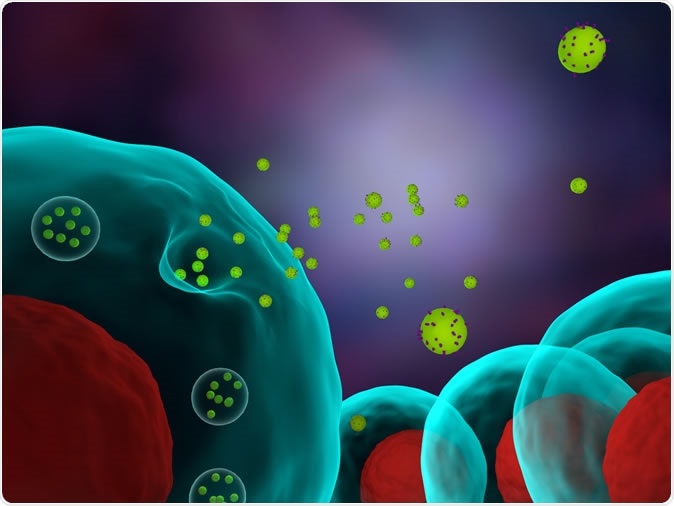A brand-new technique of gene therapy was reported on December 16, 2019, in the journal Nature Biomedical Engineering. The scientists made use of the potential of human cells to produce biological nanoparticles chockful of edited genes, so that they could insert beneficial genes into people suffering from various disease processes.
The proof-of-concept study proved more than just that it was a good idea: in mice that had been induced to develop the brain tumor called glioma, the therapy slowed down the growth rate of the tumor as well as enabling them to live longer. The finding becomes even more significant when we remember that gliomas account for 8 out of 10 brain tumors in humans.

3d illustration of cells releasing exosomes. Image Credit: Meletios Verras / Shutterstock
The secret weapon
The scientists working on the current study made use of the cell organelles called exosomes. These are tiny bubbles bounded by membranes and released by the cells in order to carry signal molecules to other cells. These naturally occurring membranous sacs, or vesicles, are biocompatible as well as capable of carrying payloads around the body. They don’t rouse an immune reaction because they are part of the host’s own body. Moreover, there are a lot of exosomes in every cell.
The challenge facing the scientists was to compress the needed genetic data inside the nanosized exosomes. To be effective, the genetic code must be quite large in size. The solution arrived at in the present work was to use human cells to manufacture exosomes on a very large scale. The researchers then enriched the resulting solution to collect millions of exosomes and purify them. These were then pressed into use as drug carriers.
The exosomes have a unique advantage – once they are injected into the blood circulation, they travel to the right spot to release their load, without faltering. These can cross even the blood-brain barrier without having to be present in high concentrations, unlike other particles.
Researcher James Lee describes the drug-carrying exosomes as “Christmas gifts: The gift is inside a wrapped container that is postage paid and ready to go.” Calling this “a Mother Nature-induced therapeutic nanoparticle”, he says they keep on giving.
The first discovery
It was in 2017 that Lee and his then team discovered a new technique to help convert adult cells into any required cell type that could treat disease conditions in the patient’s own body. This novel method called tissue nanotransfection had the potential to advance regenerative medicine. Here they employed a chip that used nanotechnology to unload its cargo of biomolecules straight into the skin layers, to stimulate the differentiation of skin cells into other types of cell as needed.
The researchers made the further discovery that tissue nanotransfection worked via exosomes – these were the vehicles that transported the regenerative stimuli into cells deep below the surface of the skin.
The next step
In the current study, they adapted this to develop a new technique which they dubbed cellular nanoporation.
Here, they put about a million cells donated from human tissues, such as the mesenchymal cells retrieved from human fat, on a specially modified silicon chip engineered at nanoscale. They then forced artificially modified DNA into the cells using an electrical field. Among the effects of this “forced feeding” with DNA, the cells had to expel the unnecessary messenger RNA transcribed from the synthetic DNA, and also to repair the holes that had been created by the forcible entry of the DNA.
To do this, the cells use exosomes to bag the garbage, and to restore membrane integrity. In so doing, they release exosomes that contain the drug (mRNA) coded for by the artificial DNA. The researchers thus forced the body’s own cells to produce nanoparticles containing the required therapeutic agent, from scratch, by transcribing the new DNA they introduced.
The use of electricity to stimulate the entry of the synthetic DNA had another advantage – it improved the number of therapeutic genes by 3 orders of magnitude because of the immense number of exosomes released by the cells. This signals the scalability of the model to a level that is sufficient to produce a robust effect in the human body.
The study
The selection of the right genes to repair any genetic problem is a crucial step in this process. Here, the researchers tested the effects of the PTEN gene on gliomas. This is a gene that suppresses cancerous changes. If affected by inhibitory or non-functional mutations, it allows unchecked growth of the cancer cells.
To feed this to the glioma cells, the researchers copied the gene exactly, and then introduced the artificial DNA. This was transcribed by the cell into a mRNA molecule that tells the cell how to make a certain protein. The exosomes produced by these cells as part of the repair and cleanup process contain this mRNA and can easily cross the blood brain barrier to deliver the therapeutic gene at the required site – the brain.
The implications and benefits
The advantages of this therapy are obvious: exosomes are nontoxic, and nonimmunogenic. They can travel freely in the body, crossing almost every barrier, including the blood-brain barrier – which stops most drugs. Moreover, they are programmed to target the right spot, so that they don’t inadvertently kill off normal cells.
Further testing showed that most of the exosomes were likely to end up in the brain tumor and inhibit tumor cell growth compared to other molecules used as controls. This means that apart from brain tumors, this therapy could deliver repair genes in conditions like Alzheimer’s and Parkinson’s disease.
Lee says, “Hopefully, one day this can be used for medical needs,” Lee said. “We’ve provided the method. If somebody knows what kind of gene combination can cure a certain disease but they need a therapy, here it is.”
Journal reference:
Yang, Z., Shi, J., Xie, J. et al. Large-scale generation of functional mRNA-encapsulating exosomes via cellular nanoporation. Nat Biomed Eng (2019) doi:10.1038/s41551-019-0485-1, https://www.nature.com/articles/s41551-019-0485-1